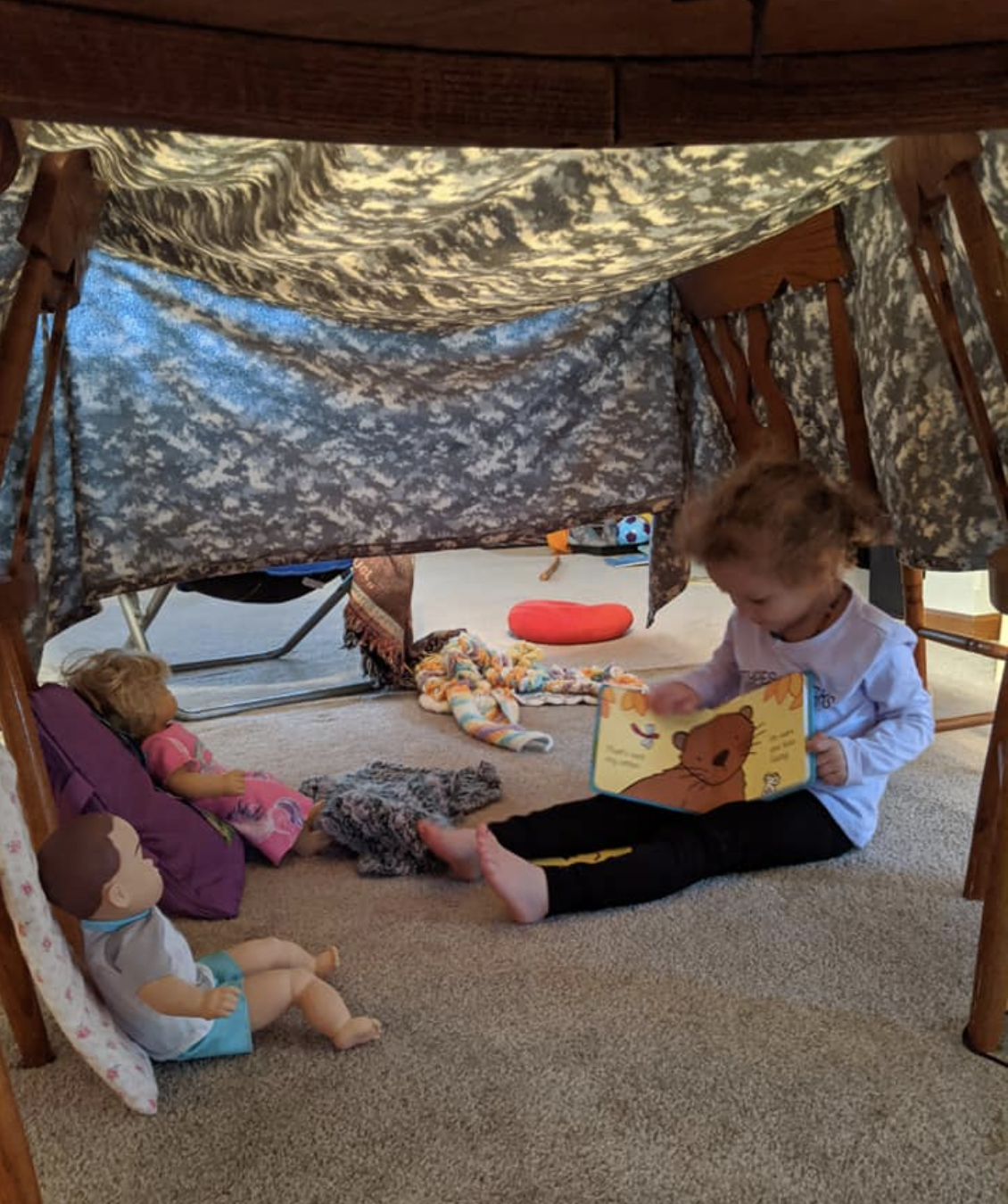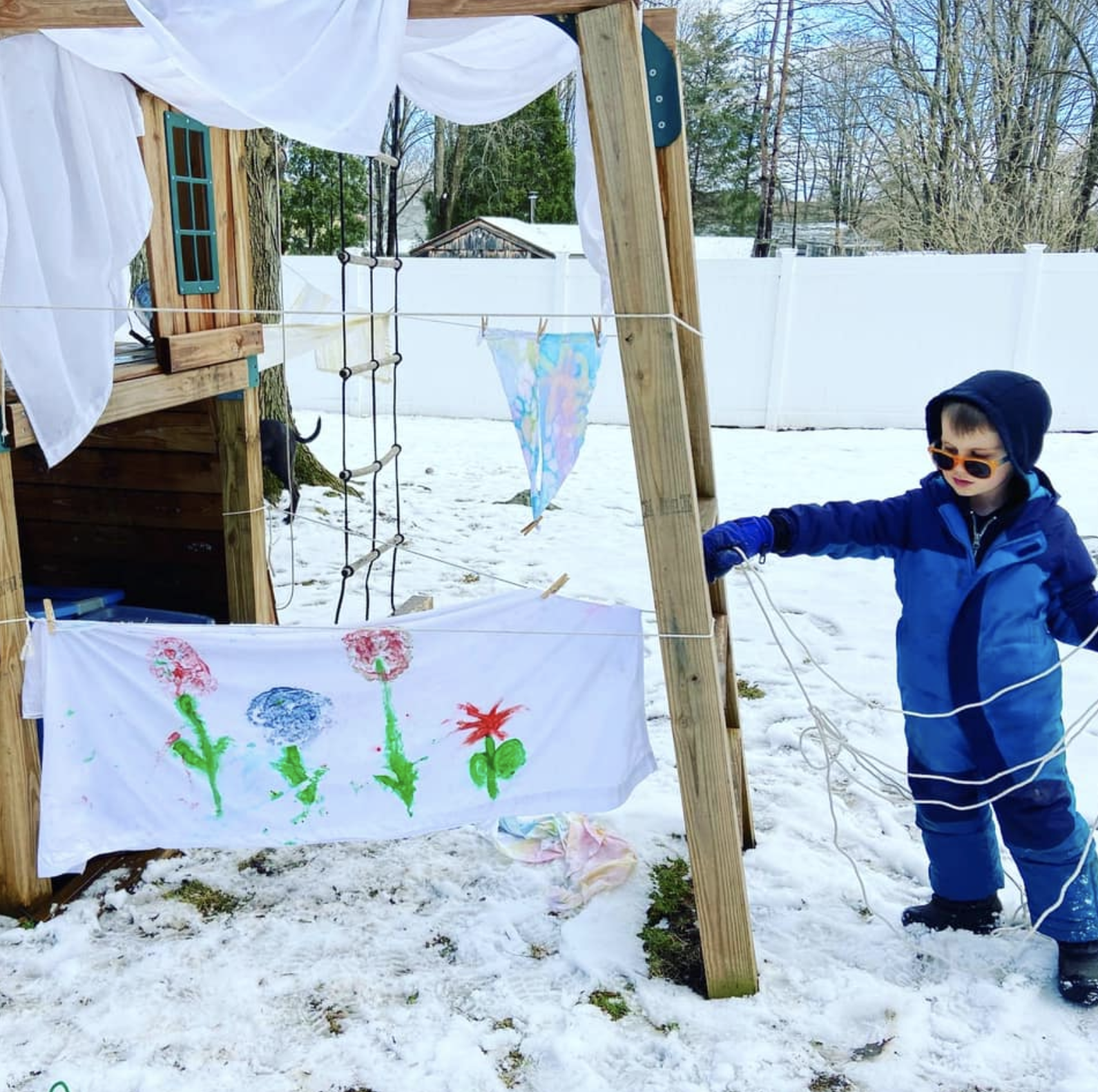If you’ve ever watched kids play with forts, you know firsthand how well these makeshift constructions inspire little ones. They tend to keep them engaged for hours so they’re just the kind of magic parents love. But fort-building doesn’t just keep kids busy — it also has a range of learning benefits for children of all ages. Even better news — setting the stage for some fantastic fort play is super easy and requires no more than a couple items from around the house.
Fort play is universal.
A typical scene on any evening in my house involves a sheet draped over couch cushions and kitchen chairs with our kids burrowed inside. On one night the fort might be a dinosaur den, on another the scene for a teady bear tea party. As our kids have grown, their imaginary play with forts has evolved, but their special connection to these spaces remains unwavering.
This pastime is certainly not unique to my household. David Sobel, an expert on outdoor early education and author of Children’s Special Places: Exploring the Role of Forts, Dens and Bush Houses in Middle Childhood, has studied the ways in which children build essential body and brain skills as they organize these small worlds.
His research shows that the drive to wrap, enclose or cover things or oneself is rather universal. Also referred to as enveloping/enclosing behavioral schema, it’s one of the patterns of behavior that children all over the world repeat in their independent play.
So, why is fort play so compelling for kids?
The simple act of draping a sheet over a couch cushion allows kids to create their own special world. It’s a world where their imaginations lead to limitless possibilities and where they can practice and make sense of everything they see, hear and experience in their real, big world. “The special place outside serves to symbolize the special place inside,” Sobel says. “It’s their own private chrysalis.”
These “secret hideaways” are also spaces in which children are in charge. In a big world where children often have decisions made for them, forts allow them to enjoy the autonomy of creating a space of their own design. They get to decide what it will look like, who will be a part of it, and what roles each member will have.
Fort play supports learning, too!
Any time we can provide our kids with an activity that is engaging and joyful while also supporting their learning and development, we know we’ve hit a home run!
- Fort-building is a terrific way for children to tap into their innermost engineers. As kids engage in the process of planning, trying new techniques and making adjustments to their design, they explore early STEM concepts and activate important skills like problem-solving and collaboration.
- Transforming an everyday object like a sheet into a fort, castle, house, or cave supports the development of divergent thinking, a skill that’s at the heart of creativity and helps kids innovate and generate creative solutions to problems.
- When the structure becomes disrupted from some vigorous play, kids learn to work through frustration and develop persistence as they build (and re-build...and rebuild) again.
- Forts also serve an important role in both activating the sensory system and supporting sensory self-regulation. As kids maneuver their bodies and heads in different positions to crawl in, out and around tight spaces, they activate their proprioceptive and vestibular systems, the senses that support balance, muscle coordination, attention and focus.
- The inside of a fort is generally less stimulating, providing kids with a much needed break from the intensity of the bigger world. A fort is, quite literally, a defense against outside forces. We all (adults and kids alike) need opportunities to tune out, take refuge and find a sense of inner peace.
What role can you play?
Got a sheet? The great news is that all kids need to engage in fort play is a simple bed sheet and the space and invitation to play.
Bring the sheet outside and invite your child to help you construct. “What could we make with this sheet?” You can also offer some simple construction materials, like duct tape, bungee cords or string and invite your child to use their imagination and problem-solving skills to create a space of their own.
Welcome any and all ideas and model curiosity and persistence as you test out different construction techniques. You can also check out a quick “how to” video from one of our Tinkergarten teammates to see how to use a tarp or sheet, bungee cords and stakes to create a solid fort.
Need more ideas?
Here are a few of our favorite ways to extend fort play:
Camp Out (or In): A pretend camp-out is a super way for kids to learn and practice camping skills within the comfort of an imaginary world. Download our one-page guide to camping with kiddos—a whole week's worth of pretend play activities to help you transform your fort play into a family camp-out, whether in the deep woods, backyard or the living room.
Animal play:
Invite your child to pretend to be their favorite animal and build a special home for it. “What would that animal need in its home?”
Play school:
If you are offering home school lessons, move them into the new space or welcome kids to play teacher to each other or to stuffed friends.
Pretend cooking:
Offer bowls, cups or other kitchen items to spark pretend play. Welcome children to pretend to cook a meal, gathering additional “ingredients” from outside to add to their play. “What would you like to cook? What could we use to make that?”
Eat a meal together:
Kids love experiencing familiar routines in new ways. Eat a snack together in your child’s secret hideaway.
Parachute play:
To add a physical twist to the sheet play, invite the kids and/or adults in your home to each take a corner of the sheet and coordinate moving it up and down together. Invite kids to scurry inside the sheet on its way down so they can experience the sensation of being enveloped in the fabric.
Light and shadow play:
Invite your child to experiment with flashlights inside their fort. Can they use the light to create shadows?
We all could benefit from the comfort of creating our own special world to connect with our kids and with ourselves. So, let’s grab a sheet, drape it just so, and let our kids turn it into a space for imagination and learning!



